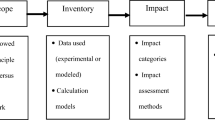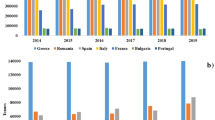Abstract
Purpose
Cheese is one of the world’s most widely consumed dairy products and its popularity is ever growing. However, as concerns for the environmental impact of industries increase, products like cheese, which have a significant environmental impact, may lose their popularity. A commonly used technique to assess the environmental impact of a product is life cycle assessment (LCA). In this paper, a state-of-the-art review of LCA studies on the environmental impact of cheese production is presented.
Methods
Sixteen LCA studies, which explored the impact from the production of a variety of cheese types (fresh, mature and semi-hard) were examined and discussed. The four stages of the LCA were examined and the range of results of selected environmental impact categories (global warming potential, acidification potential and eutrophication potential) were detailed and discussed.
Results and discussion
For each of these environmental impact categories, raw milk production was consistently found to be the most significant contributor to the total impact, which was followed by processing. It was found that allocation between cheese and its by-products was crucial in determining the impact of cheese production and standardisation or guidelines may be needed. Very little information relating to wastewater treatment system and processes were reported and this leads to inaccurate environmental impact modelling relating to these aspects of the manufacture of cheese. Very few studies included the design of packaging in terms of reducing food waste, which may significantly contribute to the overall environmental impact.
Conclusions
As raw milk production was found to have the greatest contribution to environmental impact, mitigation strategies at farm-level, particularly in relation to enteric fermentation and manure management, need to be implemented. Additionally, based on the literature, there is a suggestion that fresh cheese has less of an environmental impact than semi-hard cheeses, particularly when examining direct energy consumption. However, there needs to be more case studies investigated to justify this statement.






Similar content being viewed by others
References
Aguirre-Villegas HA, Milani FX, Kraatz S, Reinemann DJ (2012) Life cycle impact assessment and allocation methods development for cheese and whey processing. Trans ASABE 55:15. 10.13031/2013.41363
Baldini C, Gardoni D, Guarino M (2017) A critical review of the recent evolution of life cycle assessment applied to milk production. J Clean Prod 140(Part 2):421–435
Berlin J (2002) Environmental life cycle assessment (LCA) of Swedish semi-hard cheese. Int Dairy J 12:939–953
Briam R, Walker ME, Masanet E (2015) A comparison of product-based energy intensity metrics for cheese and whey processing. J Food Eng 151:25–33
Broekema R, Kramer G (2014) LCA of Dutch semi-skimmed milk and semi-mature cheese. Blonk Consultants, Netherlands
CLAL (2017) Cheese Production, European Union. CLAL. http://www.clal.it/en/?section=produzioni_cheese. Accessed 11 Apr 2017
Colombi G (2016) More cheese from less milk: eco-innovative real-time milk classification technology for optimized milk use (MilkyWay). http://www.milkyway.bio/
Crosson P, Shalloo L, O'Brien D, Lanigan GJ, Foley PA, Boland TM, Kenny DA (2011) A review of whole farm systems models of greenhouse gas emissions from beef and dairy cattle production systems. Anim Feed Sci Technol 166-167:29–45
Djekic I, Miocinovic J, Tomasevic I, Smigic N, Tomic N (2014) Environmental life-cycle assessment of various dairy products. J Clean Prod 68:64–72
Doublet G, Jungbluth N, Stucki M, Schori S (2013) Life cycle assessment of Romanian beef and dairy products. SENSE, ESU-services, Schaffhausen
EC (2006) Reference document on best available techniques in the food. Drink and Milk Industries. European Commission, Brussels
Eide M (2002) Life cycle assessment (LCA) of industrial milk production. Int J Life Cycle Assess 7:115–126
Eurostat (2017) Milk and milk product statistics. European Commission. http://ec.europa.eu/eurostat/statistics-explained/index.php/Milk_and_milk_product_statistics. Accessed 24 Feb 2017
Fantin V, Buttol P, Pergreffi R, Masoni P (2012) Life cycle assessment of Italian high quality milk production. A comparison with an EPD study. J Clean Prod 28:150–159
FAO (2016) OECD-FAO agricultural outlook 2016–2025. OECD Publishing, Paris
Feitz AJ, Lundie S, Dennien G, Morain M, Jones M (2007) Generation of an industry-specific physico-chemical allocation matrix. Int J Life Cycle Assess 12:109–117
FIL-IDF (2005) Energy use in dairy processing vol 401. International Dairy Federation, Brussels
FIL-IDF (2010) A common carbon footprint approach for dairy, a guide to standard life cycle assessment methodology for the dairy sector, vol 445. International Dairy Federation, Brussels
FIL-IDF (2015) A common carbon footprint approach for the dairy sector. The IDF guide to standard life cycle assessment methodology, vol 479. International Dairy Federation, Brussels
Finnegan W, Goggins J, Clifford E, Zhan X (2017a) Global warming potential associated with dairy products in the Republic of Ireland. J Clean Prod 163:262–273
Finnegan W, Goggins J, Clifford E, Zhan X (2017b) Environmental impacts of milk powder and butter manufactured in the Republic of Ireland. Sci Total Environ 579:159–168
Flysjö A (2012) Greenhouse gas emissions in milk and dairy product chains. PhD thesis, Aarhus University
Flysjö A, Thrane M, Hermansen JE (2014) Method to assess the carbon footprint at product level in the dairy industry. Int Dairy J 34:86–92
Garcia A, Medina B (1988) On-farm membrane concentration of milk. Trans Am Soc Agric Eng 31:274
González-García S, Castanheira EG, Dias AC, Arroja L (2013a) Environmental performance of a Portuguese mature cheese-making dairy mill. J Clean Prod 41:65–73
González-García S, Hospido A, Moreira MT, Feijoo G, Arroja L (2013b) Environmental life cycle assessment of a Galician cheese: San Simon da Costa. J Clean Prod 52:253–262
Hospido A, Moreira MT, Feijoo G (2003) Simplified life cycle assessment of Galician milk production. Int Dairy J 13:783–796
Hunt RG, Franklin WE (1996) LCA—how it came about. Int J Life Cycle Assess 1:4–7
ISO (2006a) ISO 14040: Environmental management—life cycle assessment—principles and framework. International Organization for Standardization, Geneva
ISO (2006b) ISO 14044: Environmental management—life cycle assessment—requirements and guidelines. International Organization for Standardization, Geneva
Kim D, Thoma G, Nutter D, Milani F, Ulrich R, Norris G (2013) Life cycle assessment of cheese and whey production in the USA. Int J Life Cycle Assess 18:1019–1035
Mekonnen MM, Hoekstra AY (2012) A global assessment of the water footprint of farm animal products. Ecosystems 15:401–415
Meneses M, Pasqualino J, Castells F (2012) Environmental assessment of the milk life cycle: the effect of packaging selection and the variability of milk production data. J Environ Manag 107:76–83
van Middelaar CE, Berentsen PBM, Dolman MA, de Boer IJM (2011) Eco-efficiency in the production chain of Dutch semi-hard cheese. Livest Sci 139:91–99
Milani FX, Nutter D, Thoma G (2011) Invited review: environmental impacts of dairy processing and products: a review. J Dairy Sci 94:4243–4254
Palmieri N, Forleo MB, Salimei E (2017) Environmental impacts of a dairy cheese chain including whey feeding: an Italian case study. J Clean Prod 140(Part 2):881–889
Rad SJ, Lewis MJ (2014) Water utilisation, energy utilisation and waste water management in the dairy industry: a review. Int J Dairy Tech 67:1–20
Ramírez CA, Patel M, Blok K (2006) From fluid milk to milk powder: energy use and energy efficiency in the European dairy industry. Energy 31:1984–2004
Santos HCM, Maranduba HL, de Almeida Neto JA, Rodrigues LB (2017) Life cycle assessment of cheese production process in a small-sized dairy industry in Brazil. Environ Sci Pollut Res 24(4):3460–3482
Seppälä J, Posch M, Johansson M, Hettelingh J-P (2006) Country-dependent characterisation factors for acidification and terrestrial eutrophication based on accumulated exceedance as an impact category indicator. Int J Life Cycle Assess 11:403–416
Sheane R, Lewis K, Hall P, Holmes-Ling P, Kerr A, Stewart K, Webb D (2011) Identifying opportunities to reduce the carbon footprint associated with the Scottish dairy supply chain—main report. Scottish Government, Edinburgh
Stocker TF, Qin D, Plattner G-K, Tignor M, Allen SK, Boschung J, Nauels A, Xia Y, Bex V, Midgley PM (2013) Climate change 2013: the physical science basis. Intergovernmental Panel on Climate Change, Working Group I Contribution to the IPCC Fifth Assessment Report (AR5). Cambridge Univ Press, New York
Ulrich R, Thoma G, Nutter D, Wilson J (2013) Tailpipe greenhouse gas emissions from tank trucks transporting raw milk from farms to processing plants. Int Dairy J 31(Supplement 1):S50–S56
Vergé XPC, Maxime D, Dyer JA, Desjardins RL, Arcand Y, Vanderzaag A (2013) Carbon footprint of Canadian dairy products: calculations and issues. J Dairy Sci 96:6091–6104
Weidema BP, Bauer C, Hischier R, Mutel C, Nemecek T, Reinhard J, Vadenbo CO, Wernet G (2013) Overview and methodology. Data quality guideline for the ecoinvent database version 3. Ecoinvent Report 1(v3). St. Gallen: The ecoinvent Centre, Zurich. http://lca-net.com/p/234. Accessed 6 Nov 2017
Yan M-J, Humphreys J, Holden NM (2011) An evaluation of life cycle assessment of European milk production. J Environ Manag 92:372–379
Funding
The first and last authors would like to acknowledge funding provided by the Department of Agriculture, Food and the Marine for the DairyWater project (Ref.: 13-F-507); for additional details: www.dairywater.ie. The second and third authors would also like to acknowledge funding from Enterprise Ireland (Grant No. TC 2014 0016). The last author would like to acknowledge the support of Science Foundation Ireland through the Career Development Award programme (Grant No. 13/CDA/2200).
Author information
Authors and Affiliations
Corresponding authors
Additional information
Responsible editor: Greg Thoma
Rights and permissions
About this article
Cite this article
Finnegan, W., Yan, M., Holden, N.M. et al. A review of environmental life cycle assessment studies examining cheese production. Int J Life Cycle Assess 23, 1773–1787 (2018). https://doi.org/10.1007/s11367-017-1407-7
Received:
Accepted:
Published:
Issue Date:
DOI: https://doi.org/10.1007/s11367-017-1407-7




